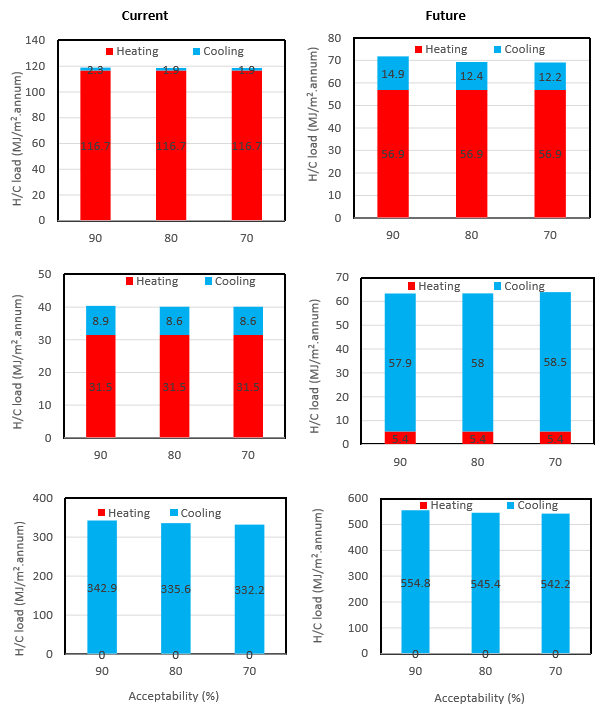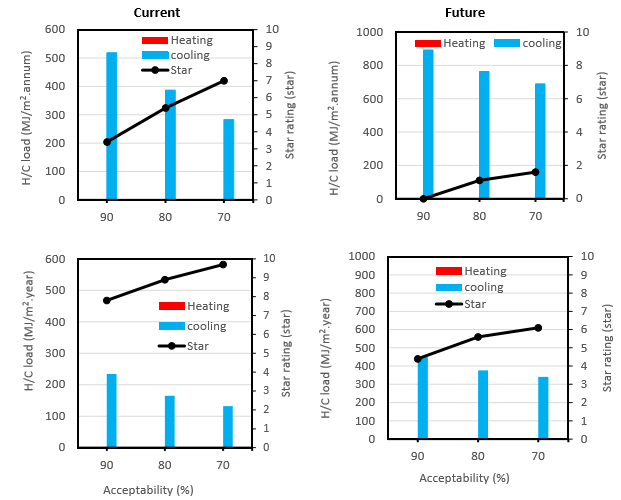Our warming climate increases the challenge for building designers to provide thermal comfort at minimum energy costs. The acceptable range for indoor temperatures is determined by the comfort temperature band within which the great majority of people are adequately comfortable. Generally speaking, for space heating and cooling less energy is required to maintain a broader indoor air temperature range than for a narrower range.
To date, there has been little critical analysis on the impact of the indoor temperature range (i.e. acceptability limits) on heating and cooling energy requirements for different constructions in different regions – under both current and future climates. This study intends to fill this research gap by investigating the impact of acceptability limits of indoor temperature on energy performance through building simulations using AccuRate.
Three houses with different thermal performance and construction are used in this study: House 1 – medium-weight colorbond slab; House 2- heavy-weight brick cavity; and House 3 – high-set, lightweight constructions. They are evaluated in the seven major Australian NCC climate zones under current and projected future climates (with an assumption of global warming of 2°C).
The main conclusions drawn from the study include: • For space cooling load under both current and future climates, the acceptability limits have greater impact on House 1 than on House 2 constructions. • The decrease from 90 to 80 per cent in acceptability limits has a greater reduction in space cooling load than the decrease from 80 to 70 per cent. • In terms of space cooling energy requirements, and house energy rating for Houses 1 and 2, the impact of reducing the acceptability limit (from 90 to 70 per cent) is minor in heating/cooling balanced regions and heating dominated regions, under the current climate. Tropical regions, such as Darwin, are most impacted -increases of 1 star for House 1 and 0.2 star for House 2 were found, due to the decrease from 90 to 70 per cent in the acceptability limits. • For the projected future climate, the impact of decreased acceptability limits will still be minor for Sydney. In Melbourne, there were decreased cooling loads of Houses 1 and 2 by around 33 and 18 per cent, respectively. • For House 3, which are common in warm tropical regions, under the current climate the decrease from 90 to 70 per cent in the acceptability limits reduces cooling load by 45.4 per cent (a 3.6 star increase). • For House 3, the energy used for space cooling can be minimized in tropical regions (9.7 stars achieved in Darwin) and subtropical regions (reduced to 5.7 MJ/m2/annum in Brisbane) using 70 per cent acceptability limits. This data is encouraging of proper lightweight construction house design and operation, to reduce space cooling loads in tropical and subtropical regions. • Global warming will reduce the impact of relaxing the acceptability limits on cooling load reduction and energy star rating of House 3.
Ongoing studies are investigating the extent that thermal comfort acceptability limits could be relaxed and still be acceptable for residential buildings in various Australian climates. With this research, revised thermal comfort acceptability limits can be proposed and implemented in design tools and energy rating schemes for residential buildings in Australia. This may facilitate more energy efficient housing designs, especially for tropical and sub-tropical regions.
Reference: Ren, Z and Chen, D (2018). Modelling study of the impact of thermal comfort criteria on housing energy use in Australia. Applied Energy 210: 152-166.

Figure 1 Sensitivity of space heating and cooling loads for House 1 under current and future climates in Melbourne (top), Sydney (middle) and Darwin (bottom)

Figure 2 Sensitivity of space heating and cooling loads for House 2 under current and future climates in Melbourne (top), Sydney (middle) and Darwin (bottom).

Figure 3 Sensitivity of space heating and cooling loads for House 3 under current and future climates in Darwin for raised construction (top) and insulated construction (bottom)
